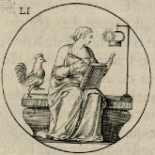A letter from Racine to Boileau
Many American libraries along the eastern seaboard, from Maine to Washington D.C. and beyond, preserve outstanding autograph collections whose riches remain to be fully explored. While their strengths lie typically, and quite naturally, in American and British material, they often contain valuable French (and Italian and German) manuscripts which are all but unknown in Europe. Such is the case for the Charles Roberts collection at Haverford College, compiled by a graduate of the College (class of 1864) and donated by his widow in 1902. Among its some 12,000 items is a letter by the playwright Jean Racine which was published from the autograph in 1807 but disappeared soon afterwards and has been out of the view of scholars and editors ever since.1

Charles Roberts Autograph Collection, Quaker & Special Collections, Haverford College, Haverford, Pennsylvania (click for larger view)
The letter is addressed to “Monsieur Despreaux,” i.e. the poet Nicolas Boileau-Despréaux, Racine’s friend and colleague as royal historiographer. The second sentence, concerning Boileau’s Epître de l’amour de Dieu and his reference to theologian Antoine Arnauld, makes it clear that the letter was written in 1698 (when January 20 was indeed a Monday). Racine also mentions his wife, his aunt (abbess of Port-Royal), his eldest daughter Marie-Catherine, and his eldest son Jean-Baptiste, who just had a meeting with Fénelon, archbishop of Cambrai. A lot of information in these nineteen lines!
In 1747, Racine’s youngest son Louis published an abridged version of the letter, omitting the last seven lines. In 1806, a partial facsimile of the autograph (which was at that time in the Bibliothèque Impériale) was published in the Œuvres de Louis XIV:
The following year, Germain Garnier included the complete text of the letter in his edition of Racine’s Œuvres complètes. But half a century later, when Paul Mesnard established the first truly modern and critical edition of Racine’s works, he no longer had access to the autograph, which had been sold at auction in 1841. Mesnard had to rely on Garnier’s transcription as well as an eighteenth-century manuscript copy; inexplicably, he omitted Racine’s signature, although it had been faithfully rendered in the 1806 facsimile and does not appear to be a later addition. Subsequent editors generally reproduce Mesnard’s text.
The consultation of the autograph does not reveal any unpublished passages but shows Racine’s original spelling, capitalization, and punctuation, which all editors have modernized and modified at will (even merging three sentences into one).2 It also allows us to examine the material aspects of the letter, written on a quarto bifolium measuring ca. 10.5 x 7.6 inches (27 x 19.3 cm). The watermark features a bird in a circle – apparently a variant of the “Pigeonne” watermark frequently used in the seventeenth century by papermakers in the Auvergne region.3

Charles Roberts Autograph Collection, Quaker & Special Collections, Haverford College, Haverford, Pennsylvania
Another bird graces the well-preserved red wax seal. Racine famously changed his family’s traditional coat of arms, composed of a rat and a swan (Rat-cygne), keeping only the swan “parce que le rat me choquait” (letter to his sister, Jan 16, 1697). The same swan stands proudly beneath the portrait of Racine engraved by Gérard Edelinck for Charles Perrault’s collection Les Hommes illustres (vol. 2, 1700).

This letter happens to be the last of the some 50 letters exchanged between Boileau and Racine that have come down to posterity; most of them are preserved at the Bibliothèque nationale de France (Français 12886; NAF 717; NAF 13091). It appears to be one of just two authentic Racine autographs currently in American collections, the other being held (since 1965) by the Morgan Library in New York City.
Volker Schröder
February 20, 2017
Footnotes
1. With the exception of a Haverford undergraduate, Alan Meltzer (class of 1985), who wrote a 22-page seminar paper analyzing this manuscript. He concludes that what “appears to be little more than a friendly note” actually “touches upon all of the major themes of the dramatist’s later life” and “reflects the dual loyalties which plagued Racine during the last two decades of his career.”
2. Transcription without modernization:
A Paris ce Lundy 20e Janv.
J’ay receû vne lettre de la Mere Abbesse de Port Royal qui me charge de vous faire mille remercimens de vos Epistres que je luy ay envoyées de vostre part. On y est charmé et de l’Epistre de l’Amour de Dieu, et de la maniere dont vous parlez de M.r Arnauld. On voudroit mesme que ces Epistres fussent imprimées en plus petit volume. Ma Fille aisnée a qui je les ay aussi envoyées a esté transportée de joye de ce que vous vous souuenez encore d’elle. Je pars dans ce moment pour Versailles d’où je ne reuiendray que Samedy. J’ay laissé à ma Femme ma quittance pour receuoir ma pension d’homme de lettres. Je vous prie de l’auertir du jour que vous irez chez M.r Gruyn. Elle vous ira prendre et vous menera dans son carrosse.
J’ay eû des nouuelles de mon Fils par M.r l’Arch.e [Archevêque] de Cambray qui me mande qu’il l’a veu a Cambray Jeudy dernier, et qu’il a esté fort content de l’entretien qu’il a [sic] auec luy. Je suis a vous de tout mon cœur
Racine.
[address:] A Monsieur / Monsieur Despreaux
3. See Raymond Gaudriault, Filigranes et autres caractéristiques des papiers fabriqués en France aux XVIIe et XVIIIe siècles, Paris: CNRS, 1995, p. 146.
Mots-clés en français: lettres de Racine à Boileau; correspondance; manuscrits et autographes dispersés.



